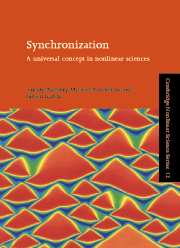Book contents
- Frontmatter
- Contents
- Preface
- Chapter 1 Introduction
- Part I Synchronization without formulae
- Chapter 2 Basic notions: the self-sustained oscillator and its phase
- Chapter 3 Synchronization of a periodic oscillator by external force
- Chapter 4 Synchronization of two and many oscillators
- Chapter 5 Synchronization of chaotic systems
- Chapter 6 Detecting synchronization in experiments
- Part II Phase locking and frequency entrainment
- Part III Synchronization of chaotic systems
- Appendices
- References
- Index
Chapter 3 - Synchronization of a periodic oscillator by external force
Published online by Cambridge University Press: 06 July 2010
- Frontmatter
- Contents
- Preface
- Chapter 1 Introduction
- Part I Synchronization without formulae
- Chapter 2 Basic notions: the self-sustained oscillator and its phase
- Chapter 3 Synchronization of a periodic oscillator by external force
- Chapter 4 Synchronization of two and many oscillators
- Chapter 5 Synchronization of chaotic systems
- Chapter 6 Detecting synchronization in experiments
- Part II Phase locking and frequency entrainment
- Part III Synchronization of chaotic systems
- Appendices
- References
- Index
Summary
This chapter is devoted to the simplest case of synchronization: entrainment of a self-sustained oscillator by an external force. We can consider this situation as a particular case of the experiments with interacting pendulum clocks described in Chapter 1. Let us assume that the coupling between clocks is unidirectional, so that only one clock influences another, and that is exactly the case of external forcing we are going to study in detail here. This is not only a simplification that makes the presentation easier; there are many real world effects that can be understood in this way. Probably, the best example in this context is not the pendulum clock, but a very modern device, the radio-controlled watch. Its stroke is corrected from time to time by a very precise clock, and therefore the watch is also able to keep its rhythm with very high precision. We have also previously mentioned examples of a living nature: the biological clocks that govern the circadian rhythms of cells and the organisms controlled by the periodic rhythms originating from the rotation of the Earth around its axis and around the Sun. Definitely, such actions are also unidirectional. We consider several other examples below.
We start by considering a harmonically driven quasilinear oscillator. With this example we explain entrainment by an external force and discuss in detail what happens to the phase and frequency of the driven system at the synchronization transition. Next, we introduce the technique of stroboscopic observation; in the following we use it to study synchronization of strongly nonlinear systems, entrainment of an oscillator by a pulse train, as well as synchronization of order n : m.
- Type
- Chapter
- Information
- SynchronizationA Universal Concept in Nonlinear Sciences, pp. 45 - 101Publisher: Cambridge University PressPrint publication year: 2001

